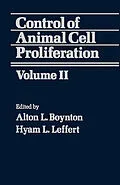Control of Animal Cell Proliferation, Volume II discusses how animal cells become proliferatively autonomous, which results in malignant behavior.
This book begins with trends and issues on membrane structure and teratocarcinoma research. The structure and function of several growth factors and their receptors such as thrombin, transferrin, glucocorticoid, and B and T cell factors are also discussed. This text likewise covers the mechanism of information transduction that includes intracellular pH and calcium. The aspects of genome organization and gene transcription are deliberated in the last chapters.
This publication provides biologists and students with a coherent picture of cell proliferation.
Inhalt
Contributors
Preface
Contents of Volume 1
I. Trends and Issues
1 Membrane Structure and Function
I. Introduction
II. Membrane Organization
III. Membrane Dynamics
IV. Diffusion-Coupled Reactions and Membrane Function
V. Some Current Problems in Membrane Structure
VI. Concluding Comment
References
2 Trends in Teratocarcinoma Research
I. Introduction
II. Embryo-Derived Stem Cells
III. Growth Factors and Oncogenes
IV. Conclusions and Prospects
References
II. Growth Factors
3 Transforming Growth Factors
I. Introduction
II. Transforming Growth Factor Type a
III. Transforming Growth Factor Type ß
IV. Other Transforming Growth Factors
V. Summary and Conclusions
References
4 Commitment in Blood Cell Differentiation: Erythropoietin as an Instructive Signal
I. Introduction
II. Biologically Active Factors
III. Precursor Cells
IV. Models of Blood Cell Differentiation
References
5 Granulocyte-Macrophage Colony-Stimulating Factors
I. Introduction
II. Murine Granulocyte-Macrophage Colony-Stimulating Factors
III. CSFs and Oncogenes
IV. Actions of the CSFs
V. In Vivo Significance of the CSFs
VI. Summary
References
6 Structural Regions and Bioregulatory Functions of Thrombin
I. Introduction
II. Prothrombin Structure
III. Thrombin Structure
IV. Active-Site Regions
V. Specificity and Bioregulatory Functions
References
7 Transferrin
I. Introduction
II. Isolation and Purification of Transferrin
III. Physical Properties of Transferrin
IV. Ligands of the Metal and Anion Binding Sites
V. The Synergistic Anion Binding Site
VI. Iron Exchange by Transferrin
References
8 Glucocorticoid Enhancement of Cellular Proliferation In Vitro
I. Introduction
II. Effects of Glucocorticoids on Cellular Proliferation
III. Additional Effects of Glucocorticoids In Vitro
IV. Enhanced Proliferation of Human Fetal Lung Fibroblasts in the Presence of Glucocorticoid-Conditoned Medium
V. Summary
References
9 B Cell and T Cell Growth Factors
I. Overview
II. Consensus Model of the T Cell Response
III. Consensus Model of the B Cell Response
IV. History
V. T Cell Growth Factors
VI. B Cell Growth Factors
VII. Summary and Conclusions
References
III. Receptors
10 Characterization of the Thrombin Receptor and Its Involvement in Initiation of Cell Proliferation
I. Introduction
II. Demonstration of High-Affinity Thrombin Receptors
III. Visualization of Thrombin Binding Sites
IV. Internalization and Degradation of Thrombin: Thrombin Receptors vs. Protease-Nexin
V. Receptor-Cytoskeletal Interactions
VI. Characterization of Thrombin Receptors on Fibroblasts
VII. Role of Thrombin Receptors in Initiation of Cell Proliferation
VIII. Characterization of Thrombin Mitogenic Signals
IX. Two-Signal Model for Thrombin Mitogenesis
X. Effect of Transformation on Thrombin Binding and Effect of Thrombin on Transformation
References
11 The Transferrin Receptor
I. Introduction
II. Transferrin Receptor Expression and Cell Proliferation
III. Evidence for Possible Roles for Transferrin Receptor Other Than Cellular Iron Uptake
IV. Conclusions
References
12 Glucocorticoid Hormone Receptors
I. Introduction
II. Receptor Assays
III. Purification of Glucocorticoid Receptors
IV. Structure of the Glucocorticoid Receptor
V. Cellular Localization of Glucocorticoid Receptors
VI. Functional Consequences of Activation
VII. Genetic Analysis of Glucocorticoid Receptors
References
13 The Antigen Receptor on T Cells
I. Ligand Specificity of T Lymphocytes
II. Structure of the Antigen/MHC Receptor on T Cells
III. Structure of the a and ß Chains of the Receptor
References
IV. Transduction Mechanisms
14 Intracellular pH and Cell Proliferation
I. Introduction
II. pH1 and Initiation of Cell Division
III. Properties and Mechanism of the pHj Increase
IV. Is the pH1 Change Necessary for Fertilization?
V. Is the pH1 Change Necessary for Growth Factor Action?
VI. How Might Na+-H+/pH1 Changes Cause Mitogenesis?
VII. Summary and Prognosis
VIII. Is a New View of pHi Required?
References
15 Intracellular Calcium and Normal Eukaryotic Cell Growth
I. Introduction
II. Intracellular Calcium Regulation
III. Calcium and Lymphocyte Activation
IV. Calcium and the Activation of Quiescent Fibroblasts
V. Common Patterns of Ionic Responses
VI. Conclusions
References
V. Regulation
16 Organization, Structure, and Function of Interspersed Repeated DNA Sequences in Mouse and Human Genomes
I. Introduction and Background
II. Genome Organization from the Perspective of Interspersed Repeated DNA Sequence Families
III. Interspersed Repeated DNA Sequences in Mouse and Human Genomes: Structural Features and Their Implied Functional Significance
IV. Concluding Notes
References
17 Molecular Mechanisms of Epidermal Growth Factor Regulation of Prolactin Gene Transcription
I. Introduction
II. Transcriptional Regulation of Gene Expression by Polypeptide Hormones
III. Nuclear Effects of EGF Blocked by Cobalt Chloride
IV. EGF Effects on Other Transcription Units
V. Mechanisms of Attenuation of Transcriptional Responses
VI. Concluding Remarks
References
Index
